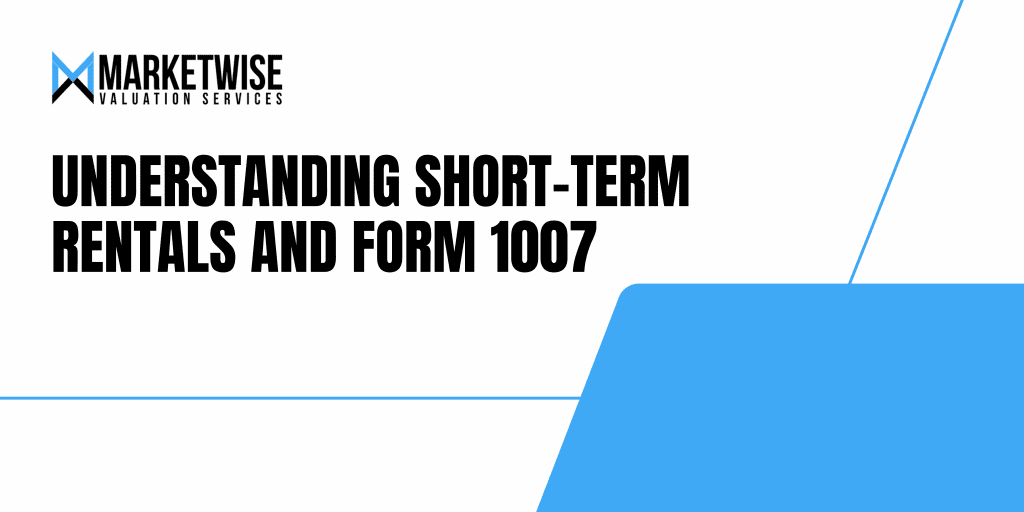
As the popularity of short-term rentals (STRs) continues to rise, many real estate professionals and lenders have questions about how these properties are evaluated, particularly when it comes to Fannie Mae’s Single-Family Comparable Rent Schedule, known as Form 1007. This form is critical in documenting the estimated monthly market rent for investment properties when an appraisal is completed for conventional lending purposes. Let’s break down how Form 1007 applies to short-term rentals and how it’s typically used in the appraisal process.
What is Form 1007?
Form 1007 is used by appraisers to estimate the monthly market rent for single-family investment properties. This form allows lenders to determine whether rental income can be considered when qualifying a borrower for a loan. Lenders are required to use Form 1007 when rental income is part of the loan qualification process for one-unit investment properties. The form is also useful for reporting gross monthly rent at loan delivery, as outlined in Fannie Mae’s Selling Guide.
In some cases, Form 1007 may be used along with tax returns or lease agreements for refinances. For purchases, the form can be used either with a lease agreement or as a standalone document to estimate rent. However, this brings up a key question: How should Form 1007 be used when it comes to short-term rentals (STRs)?
Short-Term Rentals and Form 1007
Short-term rentals differ significantly from traditional rental properties, especially in terms of how rent is collected. Short-term rent schedules usually involve agreements made on a nightly or weekly basis, much like a hotel, whereas long-term leases are structured monthly. Moreover, STRs often involve personal property, like furniture, fixtures, and equipment (FFE), which are typically not part of long-term rental agreements.
So, should Form 1007 be used to evaluate short-term rentals? While the Selling Guide does not explicitly address whether STR income qualifies as rental income, lenders have the flexibility to decide. However, the form was not designed for STRs, as it focuses on monthly market rent, and STR income is not always comparable to traditional rental income due to differences in vacancy rates, personal property, and additional services (like housekeeping or amenities).
Key Considerations for Lenders Using Short-Term 1007
If a lender decides to treat short-term rental income as business income, Form 1007 wouldn’t apply. The lender would instead use underwriting guidelines for business income. On the other hand, if a lender opts to qualify STR income as rental income, then Form 1007 must be used, but with caution. The appraiser should still evaluate monthly lease comparables, not nightly or weekly STR comparables.
It’s important to note that while lenders can request Form 1007 for an STR appraisal, the appraiser should not use nightly STR rates and multiply them by 30 days to estimate monthly rent. This approach would overlook important factors like personal property, business expenses, and vacancy rates associated with STRs.
How to Properly Use Short-Term 1007 for Appraisals
To comply with Fannie Mae’s guidelines, appraisers evaluating a short-term rental must base their analysis on comparable properties with monthly lease rates. Even if the property is used as an STR, appraisers should only include real property in their value assessment, excluding any personal property or ongoing business concerns.
Appraisers should avoid alternative definitions and methodologies when completing short-term 1007 forms. Using STR comparables incorrectly can lead to misleading property valuations, as the short-term rental market operates differently than traditional rental markets.
Conclusion
While short-term rentals (STRs) offer a unique investment opportunity, the rules for appraising them differ from those for long-term rental properties. If you’re a lender or real estate professional dealing with STRs, understanding how to correctly use Form 1007 is essential. Although the Selling Guide allows some flexibility, appraisers must rely on traditional monthly market rent comparables and should not factor in STR rates or personal property in their evaluations.
In cases where short-term rental income is treated as rental income, Form 1007 plays a crucial role in determining gross monthly rent for conventional lending purposes. However, if the income is categorized as business income, Form 1007 is not required. By adhering to the proper methodologies, lenders can ensure accurate appraisals and avoid the pitfalls of misvaluing short-term rental properties.
Need help with your appraisal process? Contact us today to learn how we can assist you in implementing these new ROV requirements effectively.

- Marketwise Valuation Services, Inc.
- 7100 Biscayne Blvd, Suite 207
- (888) 602-9299
- appraisals@marketwisevaluation.com
- www.marketwisevaluation.com
